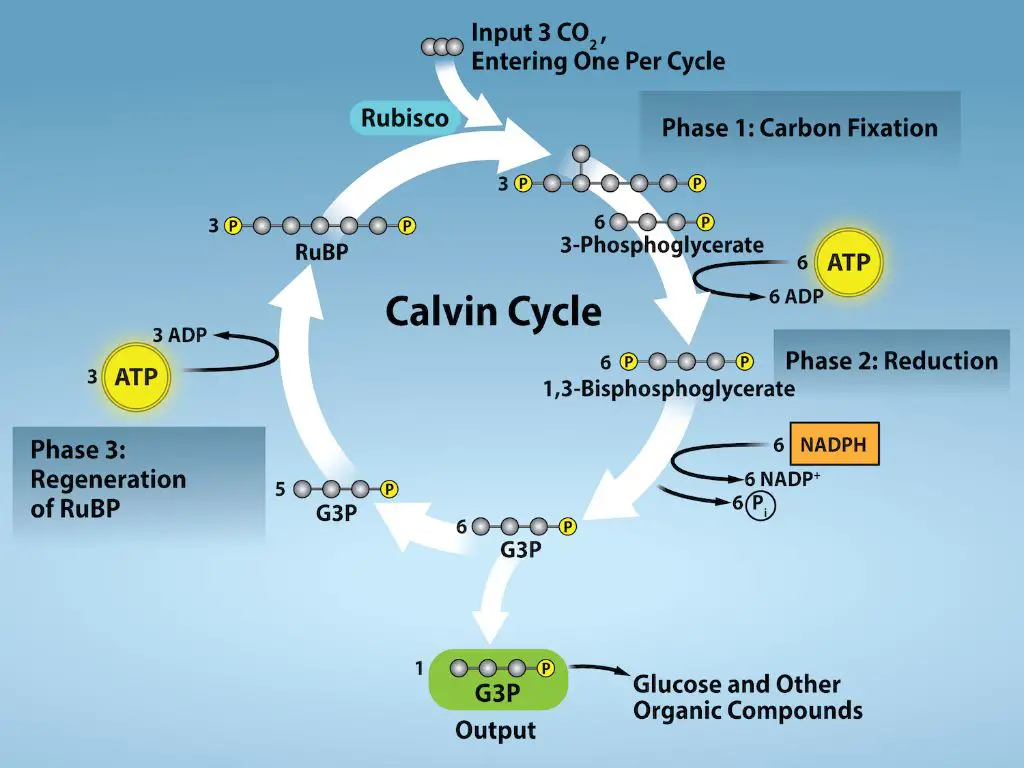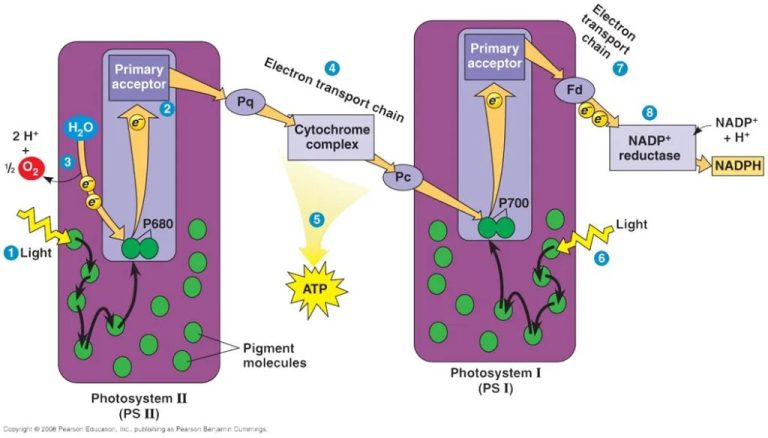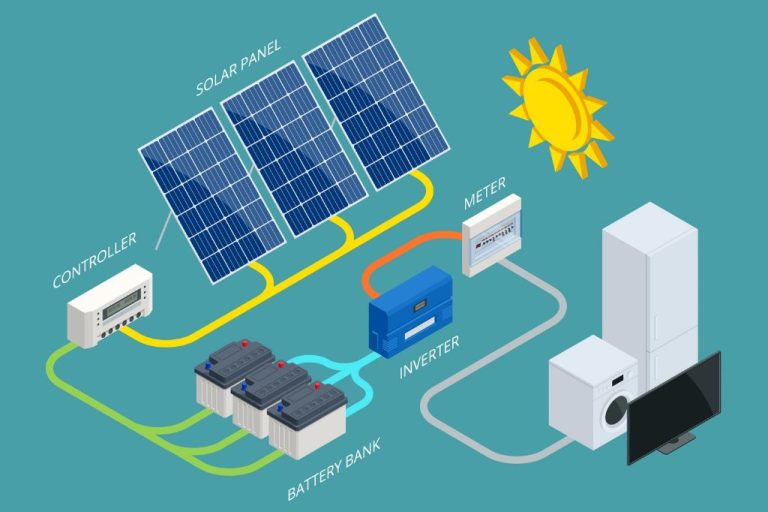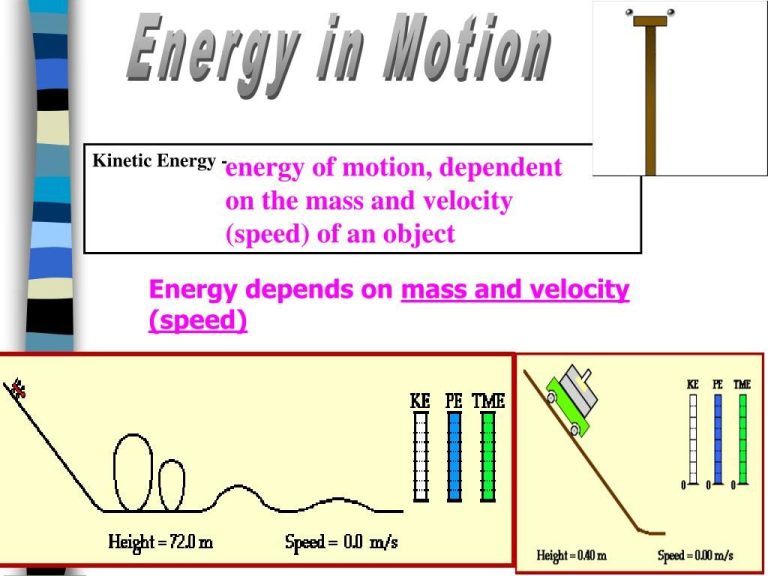Is Light Energy Converted To Chemical Energy In The Calvin Cycle?
Photosynthesis is the process plants and other organisms use to convert light energy from the sun into chemical energy in the form of carbohydrates. This chemical energy is stored in the bonds of glucose molecules and other carbohydrates, which plants can break down to fuel their cellular activities. The Calvin cycle, also known as the light-independent reactions, is the set of chemical reactions that converts the carbon from carbon dioxide in the atmosphere into carbohydrates using the energy captured from sunlight.
The Calvin cycle takes place after the light-dependent reactions, in which light energy is captured and converted into chemical energy carriers like ATP and NADPH. The Calvin cycle then uses these energy carriers to power the fixation of carbon dioxide into three-carbon sugars, providing the raw material for carbohydrate synthesis. So in summary, the Calvin cycle is the final stage of photosynthesis where the energy from sunlight is converted into and stored as chemical energy in organic molecules.
The Light Reactions
The light reactions of photosynthesis occur in the thylakoid membranes of chloroplasts. This is where light energy from the sun is absorbed by chlorophyll and converted into chemical energy in the form of ATP and NADPH.
When light strikes chlorophyll, electrons are excited to a higher energy state. These energized electrons are captured through a series of reactions that ultimately produce ATP and NADPH. Oxygen is also produced as a byproduct of these reactions.
Specifically, two photosystems are involved – Photosystem II and Photosystem I. As photons hit Photosystem II, electrons are energized and passed through an electron transport chain. This creates a proton gradient which drives ATP synthase to produce ATP. The energized electrons are then passed to Photosystem I, producing more ATP and also NADPH.
In summary, the light reactions harness light energy to generate ATP for energy and NADPH for reducing power. These will be used in the next stage of photosynthesis, the Calvin cycle.
The Calvin Cycle
The Calvin cycle, also known as the light-independent reactions, is the second stage of photosynthesis that converts the energy from the light reactions into chemical energy in the form of glucose. This cycle was discovered by scientist Melvin Calvin in the 1950s.

The Calvin cycle takes place in the stroma of the chloroplast and utilizes the NADPH and ATP generated from the light reactions. There are three main stages:
- Carboxylation – CO2 from the atmosphere is incorporated into an acceptor molecule RuBP by the enzyme RuBisCO. This forms unstable 6-carbon compounds that immediately split into two 3-carbon molecules called 3-phosphoglycerate (3-PGA).
- Reduction – The 3-PGA is then phosphorylated by ATP to form 1,3-bisphosphoglycerate (1,3BPG). NADPH provides the hydrogen and electrons to reduce 1,3BPG into glyceraldehyde-3-phosphate (G3P), which can continue through the cycle.
- Regeneration – Most of the G3P is used to regenerate RuBP so the cycle can continue. Additional ATP is used to convert G3P back into RuBP. Only one out of six G3P molecules exits the cycle to be used in glucose synthesis.
The end result is the production of G3P and the regeneration of RuBP, allowing the Calvin cycle to repeat. G3P contains the stored chemical energy from the light reactions that can be used to fuel the cell’s activities.
Rubisco
Rubisco is an enzyme that plays a critical role in the Calvin cycle by fixing carbon dioxide. The name Rubisco comes from “ribulose bisphosphate carboxylase/oxygenase”, describing its dual functions. As a carboxylase, Rubisco attaches CO2 to ribulose-1,5-bisphosphate (RuBP), a 5-carbon molecule. This forms an unstable 6-carbon compound that immediately splits into two 3-carbon molecules called 3-phosphoglycerate (3-PGA).
The binding of CO2 by Rubisco is the first step in reducing, or fixing, carbon dioxide into organic carbon compounds that can be used by cells. This CO2 fixation is absolutely essential to life, as it incorporates inorganic carbon from the atmosphere into organic molecules that all organisms depend on. Without Rubisco catalyzing this reaction, the Calvin cycle would not function and photosynthetic organisms could not survive.
Conversion of Light Energy
In the light reactions of photosynthesis, light energy is converted into chemical energy and stored in the bonds of two molecules, ATP and NADPH. This conversion happens through a series of reactions catalyzed by proteins within the thylakoid membranes of chloroplasts.
When light hits chlorophyll in the photosystems of the thylakoid membranes, it excites electrons to a higher energy state. These energized electrons get passed through an electron transport chain, and as they move from one carrier protein to the next, they lose energy. This energy gets used to pump hydrogen ions across the thylakoid membrane, creating an electrochemical gradient.
The movement of hydrogen ions back across the membrane powers ATP synthase to produce ATP. ATP is a molecule that can store chemical energy in its phosphate bonds. The energized electrons that made it through the entire electron transport chain reduce NADP+ to NADPH, which also stores chemical energy in its bonds.
So in summary, light energy gets converted into chemical energy that is stored in ATP and NADPH through a series of light-driven reactions in the thylakoid membranes. These energy carrier molecules then provide the chemical energy needed to power the next stage of photosynthesis, the Calvin cycle.
Production of G3P
The Calvin cycle produces a 3-carbon sugar called glyceraldehyde 3-phosphate (G3P). This happens through the following steps:
Ribulose 1,5-bisphosphate (RuBP) reacts with CO2 and becomes a 6-carbon intermediate which quickly splits into 2 molecules of 3-phosphoglycerate (3-PGA).
An ATP molecule donates a phosphate to each 3-PGA, turning them into 1,3-bisphosphoglycerate (1,3-BPG).
Then NADPH donates a hydrogen, which reduces 1,3-BPG into G3P.
Therefore, for each CO2 that enters the cycle, 1 G3P molecule is produced along with the regeneration of the RuBP molecule. The newly produced G3P represents stored chemical energy that can be used by the plant.
Regeneration of RuBP
RuBP (ribulose-1,5-bisphosphate) is a 5-carbon sugar that functions as the CO2 acceptor in the Calvin cycle. After Rubisco catalyzes the attachment of CO2 to RuBP, the resulting 6-carbon intermediate quickly splits into two 3-carbon molecules called 3-phosphoglycerate (3-PGA).
In order for the Calvin cycle to continue turning, RuBP must be regenerated. This happens through a series of reactions that convert the 3-PGA back into RuBP:
- 3-PGA is phosphorylated by ATP to form 1,3-bisphosphoglycerate (1,3-BPG). This attaches a phosphate group onto 3-PGA.
- 1,3-BPG is then reduced by NADPH and loses a phosphate group to become glyceraldehyde-3-phosphate (G3P). Remember NADPH is the reducing power generated from the light reactions.
- Most of the G3P continues on to make glucose and other carbohydrates. However, some of the G3P is used to regenerate RuBP, which enables the Calvin cycle to continue.
- G3P goes through multiple rearrangements and the addition of more phosphate groups from ATP to regenerate RuBP.
In summary, the regeneration of RuBP requires energy in the form of ATP and reducing power in the form of NADPH. This resupplies the CO2 acceptor RuBP so that the Calvin cycle can keep incorporating CO2 into carbohydrates.
Storage of Chemical Energy
The Calvin cycle produces a 3-carbon sugar called glyceraldehyde-3-phosphate (G3P). This molecule contains energy from the light reactions in the form of chemical bonds. G3P can be used directly as a simple sugar, or it can be combined with other G3P molecules through additional reactions to form larger, more complex carbohydrates like glucose and sucrose.
These more complex carbohydrate molecules are a way for plants to store the energy they have captured from the sun. The chemical bonds in these molecules represent stored energy that the plant can later use for food, growth, and other biochemical processes. So in summary, the Calvin cycle converts the light energy into chemical potential energy by producing high-energy carbohydrates that store the energy in their molecular bonds.
The Relationship Between Light Energy and Chemical Energy
In photosynthesis, light energy is initially converted into chemical energy. This begins when light is absorbed by chlorophyll and excites electrons in the thylakoid membranes of chloroplasts. The excited electrons are then transported down an electron transport chain, which drives the production of ATP and NADPH. ATP and NADPH carry chemical energy that is then used to power the reactions of the Calvin cycle.
The Calvin cycle, which takes place in the stroma of chloroplasts, converts the chemical energy stored in ATP and NADPH into the chemical bonds within carbohydrates, specifically a 3-carbon sugar called G3P. The enzyme Rubisco catalyzes the fixation of carbon dioxide, incorporating it into organic molecules that are reduced using electrons supplied by NADPH. Additional energy from ATP is required to drive this reduction process.
In summary, light energy powers the light reactions to produce ATP and NADPH, which supply chemical energy to the Calvin cycle. The Calvin cycle then uses this chemical energy to convert CO2 into carbohydrates like G3P. Therefore, there is a direct relationship between the light energy captured by chlorophyll and the chemical energy stored in the organic compounds produced by the Calvin cycle.
Conclusion
In conclusion, light energy is converted and stored as chemical energy through the light reactions and Calvin cycle in photosynthesis. The light reactions harness light energy from the sun to produce ATP and NADPH. This energy is then used in the Calvin cycle, where CO2 is fixed by the enzyme Rubisco to produce 3-phosphoglycerate (G3P), which contains stored chemical energy. G3P is further converted through a series of steps to regenerate the CO2 acceptor RuBP, while some G3P exits the cycle to be used for glucose and other carbohydrate production. Therefore, the light energy from the sun is ultimately converted and stored in the chemical bonds of carbohydrates through the coordinated actions of the light reactions and Calvin cycle. This process allows plants to utilize the sun’s energy for growth and survival.




